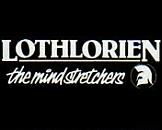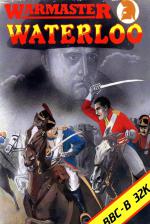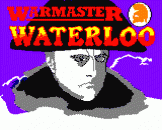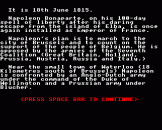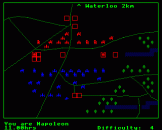Introduction
It is June 18, 1815. Napoleon Bonaparte, on his 100 day spell of liberty after his daring escape from the Island of Elba, is once again installed as Emperor of France.
You, Napoleon, must now defeat the Anglo Dutch army under the Duke of Wellington and the Prussian army of Blucher. Failure will mean exile on St. Helena.
Waterloo is a one or two player wargame re-enacting this historic battle. The game allows for keyboard or joystick control (these have to be twin joysticks for two player battles) and the game is fought in real time with the feature of simultaneous movement and combat by both sides.
There are ten levels of play.
This pack contains one cassette or disc together with a detailed booklet giving full details of playing instructions.
About The Game
Waterloo has been designed as either a one or a two player wargame, to recreate the circumstances facing Napoleon and, in the two player game, Wellington, in such a way that the player can assume their parts in the battle. The game can be played either with the keyboard or joysticks (in the two player game these must be twin joysticks) and the whole of the battle is fought in real time with both players (ro the single player and the computer) making their decisions and movements simultaneously. This game is not broken up into discreet game turns but is one of constant movement.
In order to make this continuous movement possible the graphics have ben designed to occupy only a single screen so that all pieces can be readily accessed by the players without the problem of scrolling a map and placing your opponent at a disadvantage.
The two player game will be as difficult as the ability of your opponent allows but the one player game has selectable levels of difficult ranging from 0 (easy) to 10 (very hard). Finally there is a demonstration mode in which the computer will play both sides.
Background
It is 18th June 1815. Napoleon Bonaparte, on his 100 day spell of liberty after his daring escape from the Island of Elba, is once again installed as Emperor of France.
Napoleon's plan is to march to the city of Brussels and to count on the support of the people of Belgium. He is opposed by the armies of the Seventh Coalition (Great Britain, Holland, Prussia, Austria, Russia and Italy).
Near the small town of Waterloo (18 kilometres south of Brussels) Napoleon is confronted by an Anglo-Dutch army under the command of the Duke of Wellington and a Prussian army under Blucher.
In the preceding days, Napoleon had used brilliant tactics and had placed his forces between the armies of Wellington and Blucher. Consequently Napoleon is able to do battle with the Ango-Dutch army alone rather than facing the combined frces of Blucher and Wellington together.
However, Blucher is not defeated and he is rushing from the east to come to the aid of Wellington on the battlefield. The Duke knows that he has to fight a defensive battle and play for time, whilst Napoleon has to eliminate Wellington's army before the arrival of Blucher's reinforcements.
To Napoleon's disadvantage, heavy rain has falled the preceding night, making the ground sodden and it is difficult to move artillery with rapidity and ease. The attack is, therefore, postponed by Napoleon unti 11:00am. Fate has caused valuable time to be wasted. Napoleon has to keep an eye on events beyond the woods to his right.
Wellington's position south of Waterloo was deceptively strong. Its backbone was a low narrow plateau running generally west-east. The plateau's south slope, combined with the bogging of the low ground caused by the rain, would help reduce the impact of the French attacks. Wellington had also heavily defended the two chateaux, Hougoumont and La Haye-Sainte, immediately in front of the centre of his line.
Napoleon's dispositions were such as to permit him to manoeuvre in any direction, yet they gave no preliminary hint as to the probable direction of his main effort.
Getting Started
On loading, the introduction will give you the option to read a condensed version of the instructions in this booklet or skip through to the Options Screen. You must now decide whether you want to use joysticks or keyboard - this decision cannot be changed subseqently. There is no quit command in the game, it is not possible to save a part-played game and unfortunately, after play is complete, it is necessary to reload the game if you wish to play again.
Playing The Game
The red and blue crosses on the screen are the command cursors, and these are moved using the joysticks or keyboard. Move your cursor onto one of your pieces and press the fire button. The computer will emit two tones, and await the next part of the order. The Piece will flash to show that it is awaiting a command.
If the fire button is held down too long and it emits three tones then this will render the order ineffective.
The order can be to move or to attack. To move, shift the cursor onto the required Point and Press the fire button once again. Two tones will follow and the Piece will stop flashing.
To attack, use the same procedure as for movement, only this time you must shift the cursor onto the enemy Piece within a range of 12 squares and press the fire button again. The computer will acknowledge this command. If attacking Piece is artillery, then it will fire immediately. If it is another Piece, the order will be acknowledged with two tones and the enemy Piece will be pursued until an attack is made or until the order is changed.
Artillery
A close artillery barrage of a Piece in open territory will reduce its strength by 1 if it is a weak Piece, or by 1-2 (depending on a random element) if it is of medium strength, or by 1-3 (depending on a random element) if it is strong. With a more distant barrage no more than 2 units of strength can be lost.
The strength of the firing artillery Piece is reduced by 1 each time it is fired.
Cavalry and Infantry
Cavalry Pieces are more destructive in attack than infantry, particularly against other cavalry. Infantry are best in defence or against weaker Pieces. Attack your enemy with artillery and cavalry first.
All combat in the game is governed by a slight element of chance. This is most crucial when the Pieces are large and of roughly similar strength. However, don't trust in luck, your tactical skills matter most of all.
Another element of uncertainty is that the strength of Pieces is revealed only when it is given on order, or after an attack. You have to try and remember the strengths of the Pieces of your opponent.
Artillery cannot move into defensible areas. In defensible areas, Pieces can be bombarded by Artillery and attacked by another Infantry Piece, but not by Cavalry. When in a defensible area, an infrantry Piece is stronger against attack. The effect of artillery fire on the Piece is much reduced, and it can result in a zero reduction of a defender's strength ... no casualties. Also, damage done by an infantry attack is much reduced.
Reinforcements
During the actual battle, the arrival of the Prussian forces was of vital importance in deciding the outcome.
The arrival of Blucher is timed within the program, to reproduce the actual occurence but an additional random element has been introduced to vary this somewhat within preset limits.
It is in the interests of Napolen to act rapidly before the arrival of Blucher.
Victory Conditions
The game iwll not stop at any predetermined victory point but it iwll continue as long as there are any pieces remaining on the field.
Victory conditions should be predetermined and agreed by both players before the start of the game or by yourself in the one player version. this victory condition should be expressed as the point at which both players agree to terminate the game, the winner will be determined by a points count.
Suggested victory conditions are:
- When Napoleon has five units (or another agreed number) located on the top edge of the screen, threatening Brussels
- When one player has fewer than eight units remaining on the field and his opponent has at least twelve
- When the clock reaches a pre-agreed time, carry out a points calculation
- When the strength of one player's force is twice that of the other
- Wellington's army to be reduced to an agreed points value before the arrival of Blucher.
When one of these conditions has been satisfied it will be necessary to position a cursor over each of the remaining Pieces on the battlefield and press the fire button until three bleeps are registered. The strength of that unit will be displayed at the bottom of the screen and the points for the two armies should be added to give a total for each side.
The winner will be either the player with the greatest number of points or in the case of (d) above, whether the agreed ratio of victory has been reached.
Setting the victory conditions in this general manner allows for greatest flexibility in playing the game on subsequent occasions and also allows the players to continue play if they choose until some revised victory conditions are met or indeed until one side has no Pieces remaining.
Note: Once you have satisfied yourselves that victory has been achieved, it will be necessary to reload the game in order to play again.
Victory Hints
Take your time to appraise yourself of the opening situation and the location of the main defensible points in the area before you start the game.
Make use of the easier levels to familiarise yourself with the battle and use the Pause command to give you thinking time if required. Remember, slow responses will bring Blucher onto the field before you have had an opportunity to inflict sufficient damage on Wellington.
Plan your tactics with care and give particular attention to your artillery.
An opening artillery barrage can be very effective giving decisive and immediate benefits.
The artillery, however, can be weak when directly attacked and it should either be protected against attack by the British Cavalry or else completely used up in firing against the British before it is destroyed.

|
Diversionary tactics can be useful against both the computer or another human player but always understand your own rationale behind the diversion.
Finally, you are advised to retain some strong units of infantry reserves, these can be decisive in the later stages of the battle.
Keys, Commands And Symbols
Use the following keys to move the cursor:
Wellington:
A - Left, S - Right, Z - Up, X - Down, D - Fire
Napoleon:
L - Left, + - Rigt, > - Up, ? - Down, * - Fire
If you wish to stop the game either for a break or to study your tactics then you have the facility of a pause command. This is operated by the Cursor Down button. RETURN will restart the game.
